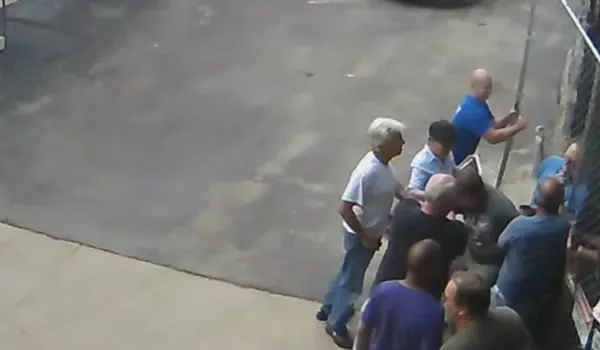Philadelphia Union Boss Boasts About Union Violence

The National Institute for Labor Relations Research has tracked violence incidents since 1975. While much of their information comes from news media accounts, it is obvious that many incidents go unreported, even to police, out of fear of retaliation.
Union bosses use tough economic times and free speech to exculpate union violence, their victims still suffer physical injury and rank and file members are coerced into paying for political activity they disagree with, as well as for the violence perpetrated by union bosses, who get off practically “scott free”. Jillian Kay Melchior has the story in National Review Online.

The engineer’s wife caught his brutal beating on camera.
As the engineer tried to enter the site through a tiny gap between a chain-link fence and a stone wall, the protesters rushed him, pressing the fence against his body and pinning him. The engineer shouted out, then howled, clutching the fence with both hands. His cries grew hysterical as he thrashed, first trying to escape, and then simply trying to shield himself. When the aggressors finally relented, he crumpled to the ground and passed out.
“It was terrifying,†the engineer tells me, asking to remain unnamed for fear of union retaliation.
The engineer’s assault was caught on tape. But despite being charged with simple assault, reckless endangerment of another person, and conspiracy simple assault, two union members, Ryan P. Stewart and Philip J. Garraty, each got off with a $200.50 fine and 18 hours of community service.
Their lawyer, Joel Trigiani, who also represents the Laborers District Council of Philadelphia, successfully petitioned for Stewart and Garraty to participate in the Accelerated Misdemeanor Program. Consequently, the incident is eligible to be expunged from both men’s arrest records.
The engineer’s experience was far from unique. Organized labor in Philadelphia has a long history of intimidation, harassment, vandalism, violence — and impunity.
A study by the National Right to Work Committee examined news reports and found that, from 1975 to 2009, there were 143 incidents of union violence in the city of Philadelphia reported in the press. It’s a grim roster that includes an unsuccessful murder attempt; a janitor’s losing an eye during a protest; the firebombing of company property; countless tires slashed; and business owners’ being threatened with a gun and with knives.
Moreover, NRTWC research suggests that for every reported instance of union troublemaking, at least ten similar incidents never make the newspapers. If those estimates are right, Philadelphia has seen an average of 45 incidents of union violence each year for nearly four decades.
And recently, many contractors and developers have reported an uptick in union troublemaking. Even some of Big Labor’s allies in Philadelphia told National Review Online that as unions started feeling economically threatened, and they have responded by behaving more aggressively.
The recession devastated Philadelphia’s already-declining construction market. At least 30 percent of Philadelphia’s union construction workers have been unemployed or underemployed since 2008.
“It’s common knowledge in the industry that there’s a 15 to 25 percent premium on construction for union versus open-shop,†Mactavish says. “That’s a lot for an owner.â€
Pat Gillespie, business manger for the Building and Trades Council, an arm of the AFL-CIO, which includes about 13 different Philadelphia unions as members, boasts:
“One person’s harassment is another person’s free-speech exercise,†he says. “Life is tough in Philadelphia, as it is in any urban area. Someone shot me from a car one time. People who tippy-toe around the edges of the city and then come in for a foray to try to do something against the standards that have been established get their feelings hurt when people call them a bastard, when people call them out for what they are. To say that we’re more expressive than any other area — maybe we do it a little louder, but the point’s the same. You have to protect what’s yours and preserve the standards that have been established for our area. â€

